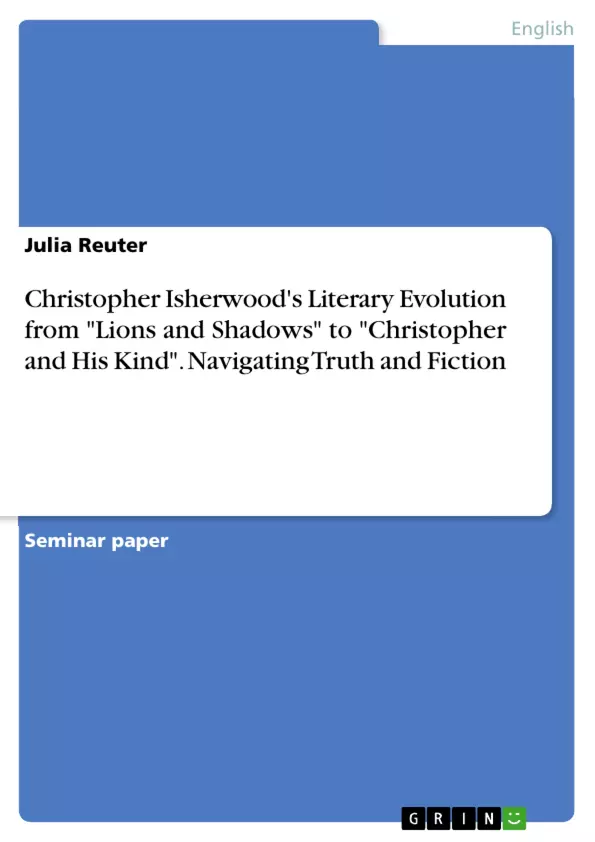Christopher Isherwood, a writer known for skilfully intertwining fact and fiction, left an indelible mark on literature. While his novels often drew upon his life experiences, he also penned autobiographical volumes that have been surprisingly overlooked in isolation. This paper focuses on Isherwood's inaugural autobiography, "Lions and Shadows," published in 1938. Despite the author's foreword urging readers to approach it as a novel, it has predominantly been treated as an autobiographical piece by scholars.
This study seeks to answer the fundamental question: Is "Lions and Shadows" a novel or an autobiography, and what was Isherwood's underlying purpose in crafting it as such? Through a meticulous examination of Isherwood's narrative techniques, thematic choices, and the interplay between fact and fiction, this paper aims to unravel the complexities of this literary work.
Additionally, the paper explores the developmental trajectory from "Lions and Shadows" to one of Isherwood's subsequent autobiographies, "Christopher and His Kind" (1976). By analysing shifts in style, content, and the author's approach to autobiography, the study sheds light on Isherwood's evolving perspective on self-representation and the dynamic relationship between his life and literary creations.
Inhaltsverzeichnis (Table of Contents)
- Introduction
- Lions and Shadows
- Subject and Plot
- Purpose and Audience
- Models of Selfhood
- Truth vs. Fiction
- From Lions and Shadows to Christopher and His Kind
Zielsetzung und Themenschwerpunkte (Objectives and Key Themes)
This text examines the development of Christopher Isherwood's self-awareness and artistic identity as reflected in his autobiographical writings, specifically focusing on his first published autobiography, "Lions and Shadows," and its relationship to his later work "Christopher and His Kind." The author explores the interplay between fact and fiction in autobiographical accounts, questioning the reliability of memory and the inherent subjectivity of personal narratives. The text delves into Isherwood's relationships with his peers, family, and his evolving perception of the artist's role in society.
- The development of self-awareness and artistic identity
- The interplay between fact and fiction in autobiography
- The influence of personal relationships on Isherwood's development
- Isherwood's evolving perception of the artist's role in society
- The significance of "Lions and Shadows" in relation to Isherwood's later autobiographical writings
Zusammenfassung der Kapitel (Chapter Summaries)
- Introduction: This chapter introduces Christopher Isherwood's work and the unique challenge of analyzing his autobiographical writings, which often blend fact and fiction. It poses questions regarding the true nature of "Lions and Shadows" - whether it is a novel or autobiography - and explores Isherwood's intentions in writing it. The chapter also outlines the broader scope of the text, examining the development of Isherwood's writing style and his evolving relationship with his past as reflected in later autobiographical works.
- Lions and Shadows: This section delves into the content and themes of "Lions and Shadows," summarizing the narrative arc and Isherwood's portrayal of his own development as a person and a writer. The chapter examines the significance of the text's subtitle, "An Education in the Twenties," and explores the various influences on Isherwood's life and writing, including his peers, teachers, and his evolving relationship with his family. The author analyzes the text's purpose and intended audience, discussing the degree to which it serves as a personal narrative or a commentary on the broader social and cultural context of the 1920s.
- Truth vs. Fiction: This chapter explores the inherent challenges of writing autobiography and the difficulties in separating truth from fiction. The author examines the reliability of memory and the inevitable subjectivity that shapes autobiographical accounts. The discussion includes Isherwood's use of diary entries and the impact of self-censorship and memory gaps on his narratives. This section raises questions about the ethical implications of blurring the lines between fact and fiction in personal writing and how these tensions shape readers' understanding of Isherwood's life and work.
Schlüsselwörter (Keywords)
This text focuses on the themes of autobiography, self-awareness, artistic identity, fact and fiction, influence of relationships, and social and cultural context. It also delves into the specific works of Christopher Isherwood, namely "Lions and Shadows" and "Christopher and His Kind," exploring the development of his writing style and his evolving relationship with his past. Key concepts include the challenges of writing a reliable autobiography, the interplay between personal experience and artistic expression, and the construction of identity through relationships and social interactions.
- Quote paper
- Julia Reuter (Author), 2010, Christopher Isherwood's Literary Evolution from "Lions and Shadows" to "Christopher and His Kind". Navigating Truth and Fiction, Munich, GRIN Verlag, https://www.hausarbeiten.de/document/1416297


